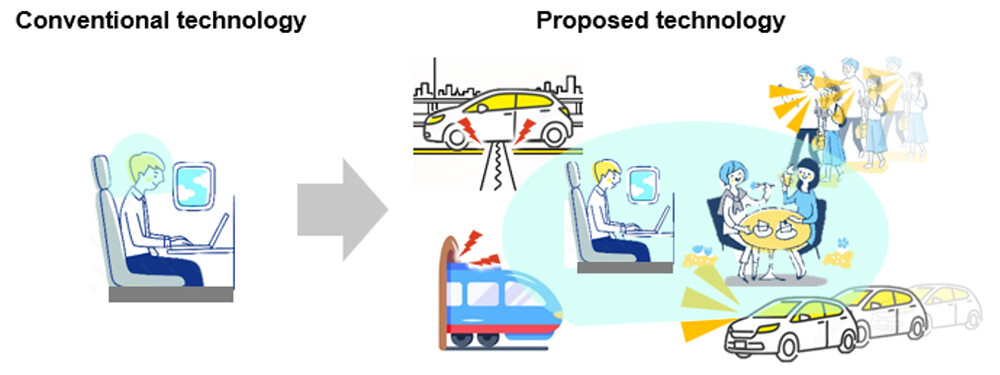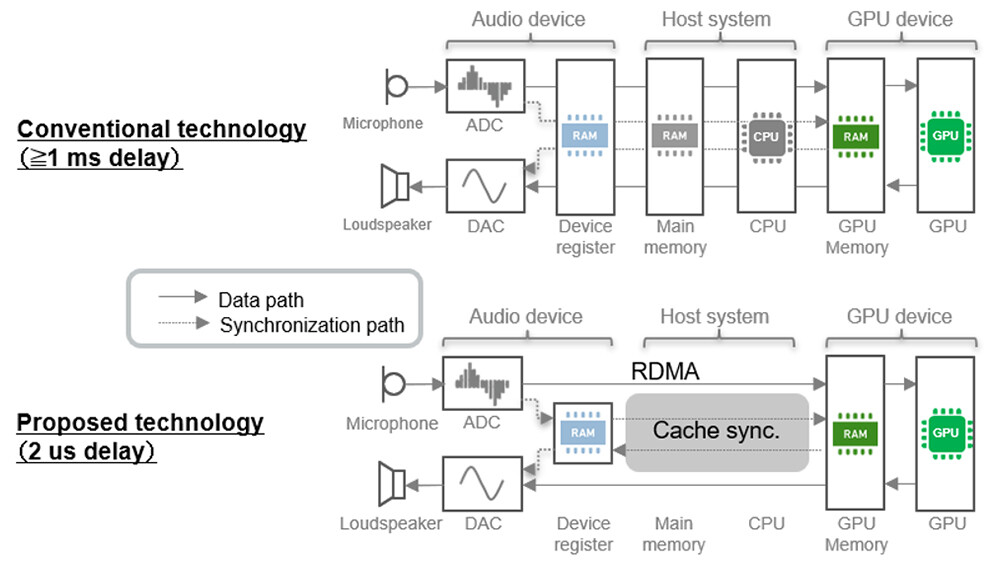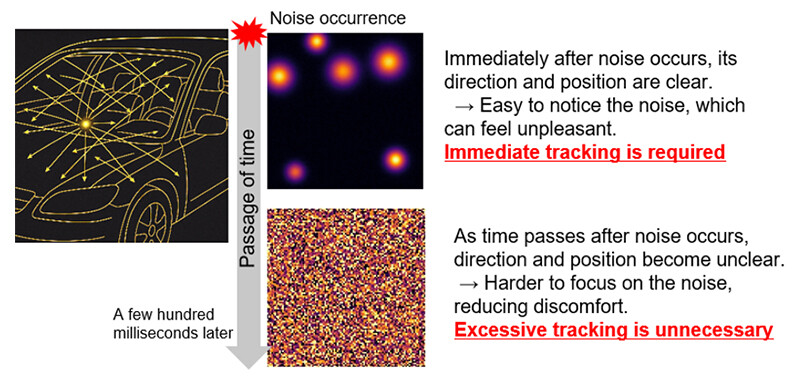Microsoft ends support for Internet Explorer on June 16, 2022.
We recommend using one of the browsers listed below.
- Microsoft Edge(Latest version)
- Mozilla Firefox(Latest version)
- Google Chrome(Latest version)
- Apple Safari(Latest version)
Please contact your browser provider for download and installation instructions.
November 13, 2025
NTT, Inc.
Spatial Noise-Canceling Technology That Rapidly Adapts to Diverse Noise Throughout Indoor Spaces
~Toward comfortable sound environments approaching WHO-ITU safe listening standards, enabling work and conversation to continue without covering the ears~
News Highlights:
- NTT has developed the world's first spatial active noise control technology on a scale of several meters (spatial ANC1), which rapidly adapts to changing noise conditions and creates a comfortable acoustic environment for multiple users simultaneously.
- By using proprietary technology that connects and synchronizes GPGPUs2 with multiple acoustic devices with ultra-low latency on the order of several microseconds, the system achieves practical in-vehicle performance and precision with power consumption 1/10,000 that of conventional solutions3.
- NTT is advancing R&D toward commercial deployment within fiscal 2026. The technology is expected to be applied not only in mobility fields such as automobiles, aircraft, and railways, but also in everyday spaces such as office meeting rooms and hotels for noise reduction.
TOKYO - November 13, 2025 - NTT, Inc. (Headquarters: Chiyoda-ku, Tokyo; President and CEO: Akira Shimada; hereinafter "NTT") has developed the world's first spatial active noise control (spatial ANC) technology that focuses on noise within environments where various sounds fluctuate, enabling the system to respond rapidly and provide a comfortable acoustic environment in which multiple users can continue working without interruption. This technology quickly tracks and effectively reduces a wide range of everyday noise, including in-cabin noise from mobility where surrounding conditions vary greatly, aircraft cabin noise, and aircraft takeoff and landing noise. As a result, users no longer need to take disruptive countermeasures such as covering their ears with both hands or wearing earplugs, which would otherwise interfere with their work.
Conventional technologies have struggled to follow dynamic spatial changes in sound, but our proprietary sound field control technology now enables real-time noise reduction. NTT is advancing research and development with the goal of commercial deployment within fiscal 2026, aiming to expand application across a wide range of fields including automobiles, aircraft, and offices.
The research results will be exhibited at NTT R&D FORUM 2025 IOWN ∴Quantum Leap4 to be held from November 19 to 26, 2025.
Background
In recent years, growing international attention has been directed toward the impact of noise on people's health and quality of life, as reflected in the WHO (World Health Organization) and ITU (International Telecommunication Union) joint recommendations on safe listening, as well as the EU Environmental Noise Directive. While vision can be easily blocked by closing one's eyes, avoiding noise typically requires blocking the ears with both hands or using earplugs, making it difficult to escape noise without interrupting daily activities.
In particular, noise in mobility environments such as automobiles, aircraft, and railways, as well as noise in urban areas near roads and railway lines, is difficult for individuals to actively block. Prolonged exposure to such noise can cause stress and adverse health effects, posing a serious challenge.
Technical Challenges
Conventional active noise control (ANC) technologies have mainly been used in steady-state environments where noise changes only slightly over time, such as during stable flight in aircraft or cruising on highways. However, in environments where noise fluctuates moment by moment, including vehicle start and acceleration, road seams, passing through tunnels, and changes in road surface, the ability of conventional ANC to accurately follow noise variations is reduced, limiting its noise reduction performance.
Furthermore, the controllable area has traditionally been limited to around the listener's head (approximately 10 cm × 10 cm), making it difficult to suppress noise across an entire vehicle cabin or in spaces shared by multiple users, such as conference rooms.
To address these challenges and provide sound environments that do not interfere with phone calls or conversation in various locations, NTT has been engaged in the research and development of spatial active noise control (spatial ANC) technology.
 Figure 1 Comparison of the proposed technology and conventional technology
Figure 1 Comparison of the proposed technology and conventional technology
In environments where noise fluctuates significantly over time, it is necessary to rapidly track multiple aspects of noise surrounding the user. Specifically, this includes (1) selecting multiple noise sources to suppress, and then following each noise source's (2) changes in position, (3) changes in tone, and (4) changes in spatial spread.
Conventional ANC technologies are limited by the processing capacity of digital signal processing (DSP) devices that handle ANC computations. This limitation restricts the number of microphones that can be processed to observe in-cabin noise. As a result, the speed of (1) selecting multiple noise sources is slow, making it difficult to track (2) changes in position and (3) changes in tone, and even more challenging to follow (4) spatial changes, such as the spread of noise, after it occurs.
 Figure 2 Overview of conventional technology and its challenges
Figure 2 Overview of conventional technology and its challenges
Technical Highlights
This technology achieves the world's first spatial ANC with high responsiveness to fluctuating noise through the following two core innovations.
■ Ultra-low latency, synchronized ANC processing technology
In spatial ANC, the system cancels noise in space by generating wavefronts opposite to the observed noise, so there is no room for temporal delay. In other words, unlike conventional so-called low-latency audio control technologies, such as wireless audio transmission via Bluetooth or low-latency two-way live streaming, both recording and playback must be performed with ultra-low latency. Furthermore, there can be no temporal misalignment between microphones during recording, between speakers during playback, or between recording and playback. As a result, practical implementation of spatial ANC requires simultaneously solving three challenges: ultra-low latency, synchronization, and the performance limits of ANC-specific DSPs.
To overcome these challenges, this technology first uses GPGPUs to exceed the processing capacity of conventional ANC DSPs. RDMA5 is employed to enable low-latency use of GPGPUs, while inter-core data synchronization mechanisms standard in modern multi-core processors are applied to maintain timing across all components. This is the first time these three challenges have been solved simultaneously. As a result, multiple microphones and speakers can be synchronized with the GPGPU at an ultra-low latency of just 2 microseconds. Leveraging the processing power of the GPGPU, the system can track and suppress noise wavefronts with 1/10,000 the power consumption of conventional ANC processors, enabling the world's first practical spatial ANC at in-vehicle power levels.
 Figure 3 Overview of the ultra-low-latency, synchronized ANC processing technology
Figure 3 Overview of the ultra-low-latency, synchronized ANC processing technology
■ Tracking technology for changes in noise spread
To further improve responsiveness to fluctuating noise, the technology employs a large number of microphones. By analyzing the acoustic information from these microphones, it efficiently tracks changes in the spatial spread of noise after it occurs. While this had been theoretically studied in the past, it was made possible by the ultra-low latency, synchronized ANC processing described above.
This technology also distinguishes between changes in the spatial spread of noise that are perceived as unpleasant and those that are not. By avoiding excessive tracking of changes that are not perceived as unpleasant, the computational load is significantly reduced to about 1/30. This allows more computational resources to be allocated to tracking changes that are perceived as unpleasant, enhancing responsiveness to noise fluctuations and achieving effective spatial noise reduction.
 Figure 4 Differences in perceived discomfort due to changes in the spatial spread of noise, and the need for noise-suppression tracking
Figure 4 Differences in perceived discomfort due to changes in the spatial spread of noise, and the need for noise-suppression tracking
 Figure 5 Example evaluation of tracking performance against varying in-cabin noise using the proposed technology. At time 0, ANC is activated:
Figure 5 Example evaluation of tracking performance against varying in-cabin noise using the proposed technology. At time 0, ANC is activated:
(a) Compared with conventional technology, the proposed approach enables users to feel the effect almost instantly, in just 1 second;
(b) It also rapidly tracks noise fluctuations without loss of accuracy.
Future Developments
This technology contributes to noise reduction and the creation of comfortable acoustic environments in both mobility and built environments. It enables noise reduction across wide areas that were previously difficult to control, such as entire vehicle cabins and conference rooms, allowing multiple users to simultaneously enjoy a comfortable space. Applications are expected across a broad range of fields, including automobiles, aircraft, railways, offices, conference rooms, hotels, residential buildings, and urban environments. For example, it can help reduce vehicle cabin and aircraft noise, urban traffic noise, and create quiet environments in conference rooms and hotels, thereby improving quality of life and reducing the impact of noise on hearing.
With the widespread adoption of this technology, noise-reduced sound environments will become more common, supporting the prevention of hearing-related health issues and enhancing comfort in daily life and work.
Going forward, NTT will continue to expand application areas and advance further technological development. Specifically, we plan to extend the technology to larger spaces and integrate it with methods informed by auditory research to provide an even more comfortable acoustic experience, which will be delivered through NTT Group's services.
Related Past Press Releases
- November 14, 2024: World's first wideband noise-canceling technology for open-ear headphones that reduces ambient noise without blocking your ears
https://group.ntt/en/newsrelease/2024/11/14/241114a.html
[Glossary]
1Active Noise Control (ANC):
A technology that detects noise using microphones and generates sound from speakers with the opposite phase to the detected noise, reducing noise through wave interference. This technology is also applied in noise-canceling headphones.
2GPGPU (General-Purpose computing on Graphics Processing Units):
A technology that uses graphics processors for general-purpose computation. It can perform many calculations simultaneously, reducing latency and enabling fast, energy-efficient processing of data for applications such as image processing and AI.
3Compared with a typical in-vehicle DSP (Digital Signal Processor) estimated at 2000 W/Tflops, the latest low-end embedded GPGPU achieves a power efficiency of 0.17 W/Tflops.
4NTT R&D FORUM 2025 IOWN ∴Quantum Leap official website: https://www.rd.ntt/e/forum/2025/

5RDMA (Remote Direct Memory Access):
A technology that allows devices to communicate data directly with each other without going through the CPU. It greatly reduces communication and processing latency, enabling microsecond-level low-latency data transfer.
About NTT
NTT contributes to a sustainable society through the power of innovation. We are a leading global technology company providing services to consumers and businesses as a mobile operator, infrastructure, networks, applications, and consulting provider. Our offerings include digital business consulting, managed application services, workplace and cloud solutions, data center and edge computing, all supported by our deep global industry expertise. We are over $90B in revenue and 340,000 employees, with $3B in annual R&D investments. Our operations span across 80+ countries and regions, allowing us to serve clients in over 190 of them. We serve over 75% of Fortune Global 100 companies, thousands of other enterprise and government clients and millions of consumers.
Media contact
NTT, Inc.
NTT Service Innovation Laboratory Group
Public Relations
Inquiry form
Information is current as of the date of issue of the individual press release.
Please be advised that information may be outdated after that point.
NTT STORY
WEB media that thinks about the future with NTT










